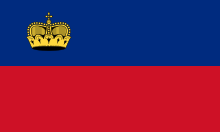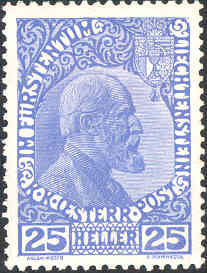Postal History and Stamps of Liechtenstein
The postal history and thus also the postage stamps of the Principality of Liechtenstein are closely linked to the postal history of Austria . The postal system in Liechtenstein was initially set up by the Austrian Post and later overseen. After the First World War , however, Liechtenstein drew closer to Switzerland for political reasons . The postal system has only been entirely in the hands of the Principality since 1999. Thanks to its earlier connection with Austria, Liechtenstein is one of the first countries to use postage stamps .
Austrian Post in Liechtenstein
Opening of the first post offices
The first proven post offices in what is now Liechtenstein can be found as early as the 16th century . At that time the important postal route from Milan to Lindau ran along the Rhine through Liechtenstein . For this purpose, two post offices were set up in Balzers and Schaan . However, a postal system for Liechtenstein itself was not set up. In the 16th to the 18th century there was no Liechtenstein postal system of its own.
At the beginning of the 19th century, the princes of Liechtenstein wanted to remedy this situation, and so they entrusted the Austrian Empire , in which they also had their residence, with the postal development of the then small German state. Finally, on September 1, 1817, the first letter collection point was opened by the Imperial and Royal Austrian postal administration in Balzers . This aroused great interest, and so another post office was founded in Vaduz in 1845 . These offices were fully connected to the rest of the Austrian postal network. Postally, Liechtenstein was treated as Austria .
Introduction of the postage stamp
This treatment became particularly important in the 1850s. In that year, the stamps were introduced in the Empire, which have now appeared on June 1, 1850 in Balzers and Vaduz. Up to that point, however, there had not yet been any contractual regulation regarding the care of the Liechtenstein postal service by Austria. This did not take place until June 5, 1852; the previous conditions were confirmed. This treaty was reconfirmed with Austria-Hungary on December 3, 1876 .
The first stamp issue for Austria and Liechtenstein showed the imperial coat of arms. The cut postage stamps were sold in denominations of 1, 2, 3, 6 and 9 Kreuzer . At the beginning, this issue was still printed on handmade stamp paper, later on machine-made stamp paper. Preserved pieces with the long stamps from Vaduz and Balzers are very rare. From the following editions, which show Emperor Franz Joseph I or the imperial coat of arms (e.g. the Kaiserkopf edition from 1858 ), only a few pieces with a cancellation from a Liechtenstein post office have become known.
In addition to the postage stamps, all other Austrian postage stamps, such as newspaper stamps and postage due stamps, appeared without restriction at the Liechtenstein post offices. Postal stationery such as envelopes, wrappers, letter cards and correspondence cards were also sold. Tax stamps , like the newspaper stamps, have also become known with Liechtenstein postmarks . Since the opening of further post offices in Nendeln on October 15, 1864, which moved to Eschen on March 1, 1912 , in Schaan on October 26, 1872 and in Triesen on July 1, 1890, their round postmarks can also be found on Austrian stamps.
First own postage stamps
On October 4, 1911, the Principality of Liechtenstein and Austria-Hungary concluded a new agreement regarding post , telephone and telegraph services in Liechtenstein. This agreement provided for the formation of a separate Liechtensteinische Post on January 1, 1912, which continued to use the k. k. Austrian Post worked together and was managed by her. It was also decided to produce their own postage stamps for the principality for the most important postage rates for letter mail, 5, 10 and 25 Heller.
Finally, on February 1, 1912, the first three Liechtenstein postage stamps appeared at the five post offices in the country. They were printed in the Vienna State Printing Office . They were designed by Koloman Moser and engraved by Ferdinand Schirnböck . These two artists were also responsible for the Austrian postal stamp series used at the same time. The Liechtenstein stamps were designed very similarly, as only the values of 5, 10 and 25 Heller were replaced. The Austrian values from 1 heller to 10 crowns could and had to be combined with them if necessary. Chalk paper was initially used as stamp paper , later ordinary stamp paper. The Liechtenstein variants of the 5, 10 and 25 hellers all showed the reigning Prince Johann II with the Liechtenstein coat of arms in the upper right corner. The inscription "K. K. Austrian Post in the Principality of Liechtenstein” provided information about the Austrian administration.
detachment from Austria
In the years that followed, more and more stamps in more and more denominations for Liechtenstein were issued by the k. k. Austrian Post issued, among other things, the first Liechtenstein special stamps were issued on the occasion of the 60th anniversary of the reign of Prince Johann II von Liechtenstein. The design and engraving were also done by Koloman Moser and Franz Schirnböck. On the day of issue, November 12, 1918, however, the administration of the Liechtenstein post by the Imperial and Royal Austrian Post ended, since on that day the imperial Cisleithania gave way to the Republic of German Austria . The First World War , which had just ended, had no major impact on Liechtenstein and its postal system, with the exception of a few brief suspensions of postal traffic in the last year of the war. In order to circumvent the settings, smaller community messenger services, such as between Vaduz and Sevelen in Switzerland, were set up.
Initially, the German-Austrian Post continued to operate the postal system in Liechtenstein. The postage stamps issued up to that point remained valid in Liechtenstein, and soon the postage stamps of the republic were also sold in the Principality. Economic problems and the beginning of hyperinflation in German-Austria also had a negative impact on the principality. By using the Austrian currency, the galloping currency devaluation was unintentionally carried along. At the beginning of 1920, the first Liechtenstein postage stamps were overprinted with higher denominations . Finally, the government of the principality decided to cancel the postal contract with Austria on February 29, 1920.
Loose cooperation with Austria
On May 5, 1920, the Liechtenstein postal service issued the first large series of postal stamps after the postal contract with Austria was terminated. It initially appeared imperforate , but a few months later it was already perforated with additional values. Liechtenstein Post continued to work loosely with Austria and used the Austrian Krona currency . For example, the new series of postal stamps came from Vienna , from Paulusson & Co., and so Austrian postage stamps could continue to be used. However, the Liechtenstein government increasingly sought contact with the Swiss government, since efforts were being made to replace the crown with the Swiss franc and subsequently to attach the principality to Switzerland economically and postally.
Swiss Post in Liechtenstein
On November 10, 1920, the first postal contract was signed with Switzerland. It provided for the Liechtenstein postal system to be managed by Switzerland without restricting the Liechtenstein postal service too severely. After it came into force on February 1, 1921, the first Liechtenstein franc stamps appeared. Austrian stamps immediately lost their face value, only the printing of Liechtenstein stamps remained in Austria.
Under the supervision of the Swiss Post , numerous issues of new postage stamps as well as the first block issues and the introduction of airmail stamps in 1930 and official stamps in 1933. Postage due stamps were already issued under the Austrian postal administration in Liechtenstein and are now being replaced. Especially in the last few decades, the country tried to sell larger quantities of stamps to collectors abroad and was successful.
In 1982, on the occasion of Moriz Menzinger 's 150th birthday , the Principality of Liechtenstein issued a three-part series of stamps depicting his landscape paintings: a 40-centime stamp with the motif of Neu Schellenberg (painted in 1861), a 50-centime stamp with a view of Vaduz (painted 1860) and a 100-centime stamp with the church hill of Bendern and the Alpine Rhine before it was straightened in the foreground (painted 1868). The Austrian stamp artist Wolfgang Seidel (* 1946) was responsible for engraving the designs .
Liechtenstein Post AG
In the 1990s, Liechtenstein strived for a completely independent postal system. The government of the principality decided to set up a Liechtenstein post office on December 18, 1998, and the Liechtenstein Post AG was founded on November 19, 1999. The postal policy and the stamp issue program tie in with the time of the Swiss post office in Liechtenstein.
With the exception of a few motifs, the stamps issued before 1996 have been invalid for franking since January 1, 2002.
Four paintings presumably by Moriz Menzinger served Adolf Tuma as the basis for a series of stamps issued by Liechtensteinische Post AG in 2011.
A special stamp was issued by Liechtensteinische Post AG to mark the opening of the Kurt Beck Watch Museum in 2018 .
web links
- Liechtensteinische Post AG with chronology
- Government Postage Office
- Earlier exchange facility for stamps expiring in 2002
- Editorial office HLFL: Post. In: Historical Encyclopedia of the Principality of Liechtenstein .
- Hermann Marxer: Philately. In: Historical Encyclopedia of the Principality of Liechtenstein .
itemizations
- ↑ Editions – Burgen in Liechtenstein on the Liechtensteinische Post website philatelie.li , retrieved on 20 June 2019.



